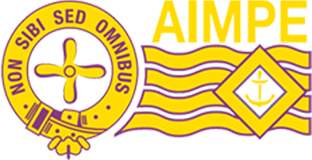ABOUT AIMPE 
Marine engineers were born of technological change and engineering diversity into a world of ever-changing ship types, engines and mechanisms. When they assembled together in the late 1870s and early 1880s they began the 'Steady Revolutions' of adaptation - to changes in technology and their interactions with others. Marine engineers set about this task in the way that they worked their engines. Just as they sought to preserve an engine's optimum efficiency by maintaining steady revolutions, so they approached the Institute, steadily, to preserve its working life and that of its membership. Hence their endeavours to find a commonality of interest with their employers. From the earliest days, engineers saw themselves not only as part of the shipping enterprise, but working to enhance it.
The history of AIMPE shows the great difficulty of balancing a commonality of interest with employers in a world where capitalist efficiency could lead to excesses against which workers felt it necessary to protect themselves by combining for fair wages and conditions.
And there were other problems. Within the Institute it was difficult to maintain the ideal of unity. The AIMPE motto, Non sibi sed omnibus (`Not for one but for all'), echoes through the years as the single enduring reason for the union to exist. It took courage to make this noble ideal a reality, and much eloquent persuasion. Unity beckoned as being attainable but the strongly individualistic marine engineer too often could not transcend the democratic structure of his organisation to practice it. The attributes that made the engineer successful on board ship seem to have worked against him in his attempts to succeed in the world of politics. Technical to a fault and often perfectionist, task oriented, and motivated by work that is tangible, the marine engineer works in the worst shipboard environment, but there is order and structure in an engine room and satisfaction to be gained from work well done. Being more comfortable with machines than people, the marine engineer was not often politically astute. The union was disadvantaged also by the inability of engineers to extend their influence and penetrate the conservative area of upper management.
A craft union, its strength based on a monopoly of skills and control of the labour supply, the AIMPE began by standing aloof from other unions, a position that became untenable with the passing of time - especially as a declining number of tradesmen-recruits from heavy industry were challenged by engineering `cadets' (now educated to degree level to increase their analytical skills), and even more since technology entered every part of the shipboard hierarchy. Today the rigid stratification is almost gone - all on board have become technicians of one sort or another.
Like its craftsmen, the shipping industry itself has been at risk during recent decades, and the AIMPE has led the way to necessary changes, to the merging of maritime unions and the restructuring of Australian shipping itself. Through these measures the industry is seeking a better way to make itself more efficient and preserve its existence. Shared interests are recognised once more, but commonality has not been achieved without-much pain. Still, in the background, the traditional struggle - wages, conditions, status of workers versus efficiency of capital - remains, waiting to be triggered if the players forget the lessons of the past.
Our book (“Steady Revolutions”) tells of the changes that marine engineers have endured and how they have survived them. Revolutions indeed, and they have faced them full on, but steadily.
Join AIMPE
To join AIMPE download the proposition form below, fill it in and return to the Branch Office in your state.
Otherwise send the completed form to Carol Godfrey at AIMPE Head Office - cgodfrey@aimpe.asn.au
Word
_____________________________________________________
